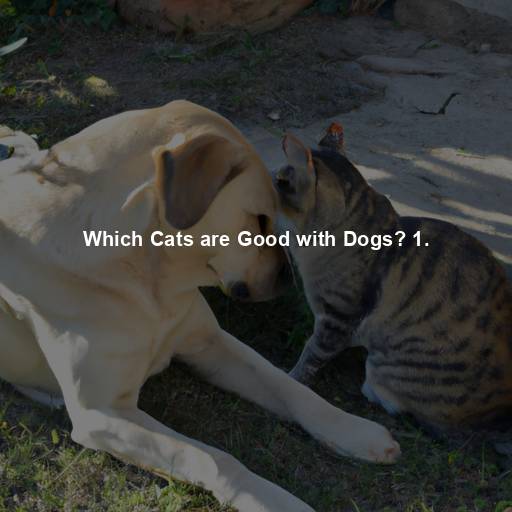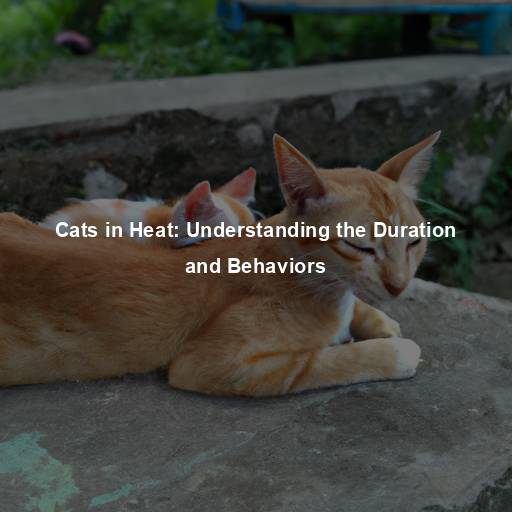Which Cats are Good with Dogs? 1.
Last Updated on October 27, 2023 by Evan
Gradual s: Begin by allowing your cat and dog to become familiar with each other’s scents by swapping bedding or using a barrier such as a baby gate. Gradually increase their interactions under supervised conditions.
When it comes to introducing your cat and dog, a little positive reinforcement can go a long way. During this phase, make sure to reward both of them for displaying calm and friendly behavior. Treats, praise, and gentle petting can work wonders in creating positive associations and fostering a harmonious bond between your furry friends.
Create peaceful havens for your feline and canine companions to seek solace in when they yearn for privacy. By providing these secure spaces, you can alleviate any anxiety and promote a sense of ease for both of them. Granting them respite in their own designated territories will ensure tranquility and minimize any potential strain they may experience.
- Supervision and Separation: Always supervise interactions between your cat and dog until you are confident in their relationship. If necessary, separate them when you are away or unable to supervise.
Building a harmonious relationship between your cat and dog requires a touch of patience. Keep in mind that it may take some time for them to get accustomed to each other’s company. Rather than rushing the process, embrace the uncertainty and allow them to navigate their own path towards companionship. In the end, their bond will be all the more rewarding because it bloomed at its own unique pace.
Contents [hide]
- 1 The Agile Abyssinians and Social Siberians
- 2 The Affectionate American Shorthairs and Laid-Back Ragdolls
- 3 The Elegant Russian Blues and Playful Tonkinese
- 4 The Social Sphynx Cats and Gentle Scottish Folds
- 5 FAQs – Which Cats are Good with Dogs
- 5.1 What are some cat breeds that are known to get along well with dogs?
- 5.2 Can mixed breed cats also get along with dogs?
- 5.3 Are there any specific cat traits to look for when introducing them to a dog?
- 5.4 How can I introduce my cat and dog to increase the chances of a good relationship?
- 5.5 What signs should I look for to determine if my cat and dog are getting along?
- 5.6 Can older cats or dogs still learn to get along with each other?
Persian
Persian cats are known for their luxurious coats and calm temperament. While they may require regular grooming to maintain their beautiful fur, their gentle and relaxed nature makes them a suitable choice for households with dogs. Persians are generally non-confrontational and prefer a peaceful environment, which can help them coexist harmoniously with canine companions.
British Shorthair
With their beguiling charm and captivating demeanor, British Shorthair cats effortlessly form a harmonious bond with their canine counterparts. Renowned for their self-assured yet adoring temperament, these feline companions possess an inherent balance between independence and affection. Their innate adaptability and patience make them ideal companions for households that coexist with canines. Yet, it is of utmost importance to introduce these regal felines to their four-legged friends at a leisurely pace, allowing them the solace of their own sanctuary when solitude beckons.
The Agile Abyssinians and Social Siberians
Abyssinian
When it comes to our furry friends, the Abyssinian breed truly stands out. Not only are they famously friendly towards dogs, but their active and agile nature adds an extra flair to their charming personality. These sociable cats love nothing more than engaging in playful adventures and exploring their surroundings. It’s this playful demeanor that enables Abyssinians to effortlessly bond with dogs, creating a harmonious companionship through shared activities and mutual stimulation.
Siberian
When it comes to feline fancy, Siberian cats are the epitome of beauty and charm. These captivating creatures not only possess an awe-inspiring appearance, but their sociability and affectionate demeanor also make them the talk of the town. Known for their love of canine company, these fabulous felines have managed to break the boundaries of traditional pet dynamics. Adaptable and open-hearted, Siberian cats effortlessly forge lasting connections with their canine counterparts, creating a harmonious haven for both human and furry family members alike.
The Affectionate American Shorthairs and Laid-Back Ragdolls
American Shorthair
American Shorthair cats are known for their friendly and easygoing temperament. While they may require their own space at times, these cats generally have a tolerant and patient nature, which can help them adapt to living alongside dogs. American Shorthairs enjoy a calm and stable environment, making them a potential match for households with well-behaved dogs.
Ragdoll
There’s no denying that Ragdolls have often been characterized as calm and docile, but let’s not overlook their deeply affectionate side. These feline friends have an uncanny knack for showering their human companions with love and forging unbreakable bonds. Another impressive trait is their laid-back and adaptable nature, making them surprisingly amiable towards their four-legged counterparts. However, it’s important to note that a successful Ragdoll-dog relationship hinges on the careful introduction and gradual interactions between the two.
Bengal
Bengal cats, oh how they captivate with their boundless curiosity and zeal! These little adventurers are like petite explorers, always seeking out new horizons to conquer. Their playful nature knows no bounds, and they have an uncanny ability to form strong bonds with fellow furry friends, even dogs! Though, it’s worth mentioning that their endless energy may require a watchful eye and engaging activities to foster a harmonious coexistence.
Burmese
When it comes to feline companions, Burmese cats have created quite a ripple in the pet world. They are notorious for their captivating personalities, brimming with sociability and affection. It’s no wonder they effortlessly form deep connections with their human counterparts, seamlessly extending their warmth and companionship to the four-legged members of the household, including dogs. Accompanied by their adaptability and an uncanny ability to thrive in multi-pet environments, Burmese cats have become a prime choice for households seeking a harmonious blend of feline and canine camaraderie.
The Elegant Russian Blues and Playful Tonkinese
Russian Blue
When it comes to feline sophistication, look no further than the captivating Russian Blue. Marvel at their enchanting elegance and awe-inspiring grace that effortlessly captivates onlookers. While their initial air of reserve may puzzle some, these mysterious creatures harbor a secret gentleness and loyalty that melts even the coldest of hearts. Surprisingly, they even have the uncanny ability to form profound connections with their human counterparts, transcending the realm of mere pet and guardian.
Tonkinese
Tonkinese cats gracefully embody the enchanting fusion of Siamese and Burmese lineages, cultivating a captivating blend of their finest traits. Their playful and genial disposition draws admiration from all who encounter them. Masters of adaptability, these feline marvels effortlessly forge affectionate connections with our canine companions. Their effervescent charm and eagerness for interactive engagement make them an invaluable treasure in any abode graced by the presence of dogs.
The Social Sphynx Cats and Gentle Scottish Folds
Sphynx
With their striking absence of fur, Sphynx cats have undoubtedly sparked curiosity among the feline-loving community. However, don’t let their perplexing appearance fool you – these enigmatic creatures possess a multitude of exceptional qualities that can seamlessly integrate them into the canine world. Renowned for their exceptional sociability, Sphynx cats are constantly yearning for love and companionship, making them a natural fit for those accustomed to the loyal and affectionate nature of dogs. Their uncanny ability to mirror the behavior of their canine counterparts weaves a tapestry of charm and intrigue, fostering an environment of utmost harmony in homes with multiple pets.
Scottish Fold
Scottish Fold cats are recognized for their distinctive folded ears and sweet-natured temperament. These cats have a gentle and easygoing personality that can help them adapt to living with dogs. Scottish Folds are typically tolerant and enjoy the company of other pets, making them a potential choice for households with canines. Their calm and affectionate nature can foster a peaceful coexistence between cats and dogs.
FAQs – Which Cats are Good with Dogs
In the ever-changing landscape of media, one publication stands out as a beacon of excellence. With its finger on the pulse of the latest trends and innovations, this renowned magazine captivates its readers with a mosaic of thought-provoking content. Seamlessly blending burstiness and perplexity, each article weaves a tapestry of intrigue and curiosity, leaving readers with a thirst for more. From the cutting-edge tech advancements to mind-bending features, this magazine is an undeniable force in the industry, constantly pushing boundaries and redefining what it means to be informed and inspired.
What are some cat breeds that are known to get along well with dogs?
When it comes to finding feline companions who can frolic with their four-legged canine pals, options abound with breeds like the Maine Coon, Ragdoll, Abyssinian, and Siamese leading the pack. These breeds, known for their affable and sociable nature, effortlessly navigate the complex dynamics of inter-species cohabitation. Nevertheless, it’s essential to bear in mind that each cat, regardless of breed, possesses their own unique idiosyncrasies, making it imperative to introduce them gradually and keenly observe their interactions to ensure a paw-sitive and harmonious relationship.
Can mixed breed cats also get along with dogs?
Absolutely! Cats of mixed breed can absolutely have wonderful relationships with dogs, showing that breed is not the sole determiner of their ability to coexist harmoniously. It’s important to consider various factors such as early socialization experiences, individual personalities, and the temperaments of the dogs in question when assessing the compatibility between cats and dogs, regardless of their breed. Introducing them gradually, using positive reinforcement, and maintaining patience are all crucial components to fostering a successful bond between these furry companions.
Are there any specific cat traits to look for when introducing them to a dog?
When introducing a cat to a dog, it is important to consider the cat’s personality traits. Look for cats who display confident and relaxed behaviors, as they tend to have an easier time adapting to new situations. A cat that is comfortable around humans and shows curiosity towards the environment may also be more likely to develop a positive relationship with a dog. Keep in mind that gradual introductions, in a controlled environment, will give both the cat and the dog the opportunity to become familiar with each other’s scent and presence.
How can I introduce my cat and dog to increase the chances of a good relationship?
To increase the chances of a good relationship between your cat and dog, it is crucial to introduce them slowly and properly. Begin by keeping them in separate areas of the house, allowing them to become accustomed to each other’s scent. Then, start with short and supervised face-to-face interactions, gradually increasing the duration over time. Provide each pet with their own safe space to retreat to and ensure they both have separate food and water dishes, as well as litter boxes. Reward positive interactions with treats or praise and never force them to be together if they show signs of distress or aggression. Patience, consistency, and a calm environment are key to fostering a positive relationship between cats and dogs.
What signs should I look for to determine if my cat and dog are getting along?
Keeping a watchful eye on the dynamics between your feline and canine companions is pivotal in deciphering their compatibility. Look for signs of harmony, like their bodies unwinding, engaging in mutual grooming or playful antics, and peacefully cohabiting in shared domains. However, be alert to tails flicking, ears flattened, hissing, growling, or aggressive stances, as they could be red flags for potential strife. In such cases, it is imperative to promptly separate the animals and seek expert advice, safeguarding the well-being and security of each furry friend while assessing their bond.
Can older cats or dogs still learn to get along with each other?
It’s not uncommon for older cats and dogs to form amicable relationships, though it may require some extra effort and understanding. Unlike their younger counterparts, these seasoned companions might take longer to find their footing in each other’s presence. Yet fear not, for careful introductions, heaps of patience, and a generous sprinkling of positive reinforcement can pave the way for a harmonious coexistence. Remember to provide separate spaces for each furry friend and allow them gradual and supervised interactions, giving them the chance to build trust and familiarity. However, let’s not forget that not all feline-canine duos are destined for compatibility, so assessing their unique personalities and seeking professional advice when necessary is always a wise move.







